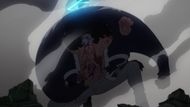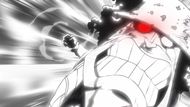Episode 1137 of One Piece has finally covered the finale of one of the most tragic characters in the entire series: Bartholomew Kuma. After years of subtle build-up, from his silent sacrifice to his disjointed reappearances as a mindless Pacifista, he cements his place as one of the most tragic heroes in One Piece
This episode is a combination of action, character drama, and symbolism to deliver a climax that answers one question for fans: Did Toei Animation truly honor Kuma’s journey? The short answer is yes. Through a mixture of powerful visual storytelling, layered flashbacks, and emotionally raw performances, Episode 1137 doesn't just do justice to Kuma—it redefines how anime adaptations can elevate source material.

The episode opens with a cinematic aspect ratio—a rare flourish reserved only for One Piece’s most pivotal moments. We are immediately pulled into a flashback of Bonney, the emotional core of this narrative thread.
In these scenes, Vegapunk gives Bonney a sun brooch and reveals the terrible truth about her father: the man who once smiled with her under the sun has been turned into a weapon by the World Government.
The subdued use of color, the stillness of the frames, and the deliberate pacing let the pain settle. Rather than rushing through exposition, the episode gives Bonney and the viewer space to grieve. This approach mirrors the heartbreak of discovering a loved one’s sacrifice, and Toei wisely chooses not to overshadow it with loud spectacle.

This visual contrast is crucial. While the manga lays the emotional groundwork, it is the anime that fully lets it breathe. The music is subtle, the lighting soft, and Bonney’s expressions of sorrow devastatingly genuine.
Bonney’s use of Distorted Future: Nika Mitaina Mirai is arguably the episode’s most creative visual moment. She tries to channel the god Nika, a figure of liberation and hope, and in doing so, she attempts to physically embody belief. But it falters—not because of lack of power, but absence of conviction.
Toei uses this moment to depict a young girl breaking under the weight of myth and expectation. What makes this sequence work is its thematic consistency. The real battle here isn’t just against Saturn—it’s against despair.
Bonney hasn’t yet connected the dots between Luffy and Nika. She still doubts, and that doubt is killing her ability to stand. It’s a visual metaphor that Toei brings to life with subtle animation cues: faltering glows, hesitating stances, and a slow drain in color that makes her vulnerability feel crushing.
Kuma’s Return in One Piece

Throughout episode 1137 of One Piece, we get glimpses of the Revolutionary Army, where Dragon senses his old friend’s movement. Wind swirls dramatically, possibly hinting at Dragon’s powers, and tension builds. But the real climax is Kuma’s relentless march to save his daughter. The animators make Kuma’s entrance nothing short of mythic. Each footstep defies pain. He barrels through Saturn’s paralyzing aura, ignoring every wound, driven only by love.
Symbolism in Saturn vs. Kuma

Episode 1137 doesn't just comprise action but also delivers symbolism. Saturn, representing the World Government's cold control, stands unchallenged, manipulating fates from the shadows. Kuma, the product of that tyranny, returns not as a puppet but as a force of justice. And not for the world but for his daughter.
The visuals in this episode of One Piece are haunting. While everyone else is paralyzed, Saturn still wields absolute power, that is, until Kuma arrives. The shot composition underscores this reversal. Saturn is framed with ominous, top-down angles. Kuma, on the other hand, is shown from below, rising, resisting, and redeeming.
And perhaps most poignantly, before the punch lands, the anime offers quick flashes of Kuma’s past. These include scenes of him being experimented on, enslaved, and betrayed, as it was all orchestrated or enabled by Saturn.
Was It a Perfect Adaptation?

Toei’s adaptation isn’t without minor critiques. Some might argue that Bonney’s Nika in One Piece attempt could have been given more visual dazzle or that a bit more time could have been spent on the Revolutionary Army’s scenes to add weight to Dragon’s role. Others might have preferred a longer confrontation with Saturn or a deeper dive into Kuma’s inner thoughts.
But to focus on these would miss the larger achievement. What Toei has delivered here is a character-focused, emotionally devastating, and beautifully directed episode that elevates the manga’s story beats. Kuma in One Piece was a man who was stripped of his body, his mind, and nearly his soul, and finally took a stand. And thanks to Ishitani’s direction, that stand feels biblical in scope.
